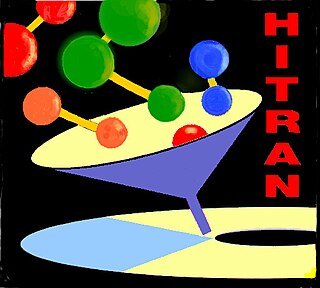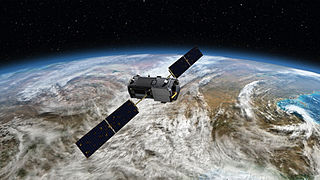
A maser is a device that produces coherent electromagnetic waves through amplification by stimulated emission. The first maser was built by Charles H. Townes, James P. Gordon, and Herbert J. Zeiger at Columbia University in 1953. Townes, Nikolay Basov and Alexander Prokhorov were awarded the 1964 Nobel Prize in Physics for theoretical work leading to the maser. Masers are used as the timekeeping device in atomic clocks, and as extremely low-noise microwave amplifiers in radio telescopes and deep space spacecraft communication ground stations.

Spectroscopy is the study of the interaction between matter and electromagnetic radiation as a function of the wavelength or frequency of the radiation. In simpler terms, spectroscopy is the precise study of color as generalized from visible light to all bands of the electromagnetic spectrum; indeed, historically, spectroscopy originated as the study of the wavelength dependence of the absorption by gas phase matter of visible light dispersed by a prism. Matter waves and acoustic waves can also be considered forms of radiative energy, and recently gravitational waves have been associated with a spectral signature in the context of the Laser Interferometer Gravitational-Wave Observatory (LIGO).
A sudden stratospheric warming (SSW) is an event in which the polar stratospheric temperature rises by several tens of kelvins over the course of a few days. The warming is preceded by a slowing then reversal of the westerly winds in the stratospheric polar vortex. SSWs occur about 6 times per decade in the northern hemisphere, and only about once every 20-30 years in the southern hemisphere.

Atmospheric sounding or atmospheric profiling is a measurement of vertical distribution of physical properties of the atmospheric column such as pressure, temperature, wind speed and wind direction, liquid water content, ozone concentration, pollution, and other properties. Such measurements are performed in a variety of ways including remote sensing and in situ observations.

Discrete dipole approximation (DDA), also known as coupled dipole approximation, is a method for computing scattering of radiation by particles of arbitrary shape and by periodic structures. Given a target of arbitrary geometry, one seeks to calculate its scattering and absorption properties by an approximation of the continuum target by a finite array of small polarizable dipoles. This technique is used in a variety of applications including nanophotonics, radar scattering, aerosol physics and astrophysics.
Thermophysics is the application of thermodynamics to geophysics and to planetary science more broadly.
An atmospheric radiative transfer model, code, or simulator calculates radiative transfer of electromagnetic radiation through a planetary atmosphere.

HITRAN molecular spectroscopic database is a compilation of spectroscopic parameters used to simulate and analyze the transmission and emission of light in gaseous media, with an emphasis on planetary atmospheres. The knowledge of spectroscopic parameters for transitions between energy levels in molecules is essential for interpreting and modeling the interaction of radiation (light) within different media.

The absorption of electromagnetic radiation by water depends on the state of the water.
GEISA - GEISA is a computer-accessible spectroscopic database, designed to facilitate accurate forward radiative transfer calculations using a line-by-line and layer-by-layer approach. It was started in 1974, at Laboratoire de Météorologie Dynamique (LMD) in France. GEISA is maintained by the ARA group at LMD for its scientific part and by the ETHER group at IPSL for its technical part. Currently, GEISA is involved in activities related to the assessment of the capabilities of IASI through the GEISA/IASI database derived from GEISA.
Codes for electromagnetic scattering by spheres - this article list codes for electromagnetic scattering by a homogeneous sphere, layered sphere, and cluster of spheres.
The Community Radiative Transfer Model (CRTM) is a fast radiative transfer model for calculations of radiances for satellite infrared or microwave radiometers.
Collocation is a procedure used in remote sensing to match measurements from two or more different instruments. This is done for two main reasons: for validation purposes when comparing measurements of the same variable, and to relate measurements of two different variables either for performing retrievals or for prediction. In the second case the data is later fed into some type of statistical inverse method such as an artificial neural network, statistical classification algorithm, kernel estimator or a linear least squares. In principle, most collocation problems can be solved by a nearest neighbor search, but in practice there are many other considerations involved and the best method is highly specific to the particular matching of instruments. Here we deal with some of the most important considerations along with specific examples.

Microwave Sounding Unit temperature measurements refers to temperature measurement using the Microwave Sounding Unit instrument and is one of several methods of measuring Earth atmospheric temperature from satellites. Microwave measurements have been obtained from the troposphere since 1979, when they were included within NOAA weather satellites, starting with TIROS-N. By comparison, the usable balloon (radiosonde) record begins in 1958 but has less geographic coverage and is less uniform.
The UAH satellite temperature dataset, developed at the University of Alabama in Huntsville, infers the temperature of various atmospheric layers from satellite measurements of the oxygen radiance in the microwave band, using Microwave Sounding Unit temperature measurements.

The Morse/Long-range potential (MLR potential) is an interatomic interaction model for the potential energy of a diatomic molecule. Due to the simplicity of the regular Morse potential (it only has three adjustable parameters), it is very limited in its applicability in modern spectroscopy. The MLR potential is a modern version of the Morse potential which has the correct theoretical long-range form of the potential naturally built into it. It has been an important tool for spectroscopists to represent experimental data, verify measurements, and make predictions. It is useful for its extrapolation capability when data for certain regions of the potential are missing, its ability to predict energies with accuracy often better than the most sophisticated ab initio techniques, and its ability to determine precise empirical values for physical parameters such as the dissociation energy, equilibrium bond length, and long-range constants. Cases of particular note include:
- the c-state of Li2: where the MLR potential was successfully able to bridge a gap of more than 5000 cm−1 in experimental data. Two years later it was found that the MLR potential was able to successfully predict the energies in the middle of this gap, correctly within about 1 cm−1. The accuracy of these predictions was much better than the most sophisticated ab initio techniques at the time.
- the A-state of Li2: where Le Roy et al. constructed an MLR potential which determined the C3 value for atomic lithium to a higher-precision than any previously measured atomic oscillator strength, by an order of magnitude. This lithium oscillator strength is related to the radiative lifetime of atomic lithium and is used as a benchmark for atomic clocks and measurements of fundamental constants.
- the a-state of KLi: where the MLR was used to build an analytic global potential successfully despite there only being a small amount of levels observed near the top of the potential.
Remote sensing of the planetary boundary layer refers to the utilization of ground-based, flight-based, or satellite-based remote sensing instruments to measure properties of the planetary boundary layer including boundary layer height, aerosols and clouds. Satellite remote sensing of the atmosphere has the advantage of being able to provide global coverage of atmospheric planetary boundary layer properties while simultaneously providing relatively high temporal sampling rates. Advancements in satellite remote sensing have provided greater vertical resolution which enables higher accuracy for planetary boundary layer measurements.

Space-based measurements of carbon dioxide are used to help answer questions about Earth's carbon cycle. There are a variety of active and planned instruments for measuring carbon dioxide in Earth's atmosphere from space. The first satellite mission designed to measure CO
2 was the Interferometric Monitor for Greenhouse Gases (IMG) on board the ADEOS I satellite in 1996. This mission lasted less than a year. Since then, additional space-based measurements have begun, including those from two high-precision satellites. Different instrument designs may reflect different primary missions.

Dirubidium is a molecular substance containing two atoms of rubidium found in rubidium vapour. Dirubidium has two active valence electrons. It is studied both in theory and with experiment. The rubidium trimer has also been observed.
Viktor Viktorovich Sobolev was a Soviet and Russian scientist, Academician of the Russian Academy of Sciences, Academician of the Academy of Sciences of the USSR, Hero of Socialist Labour (1985).










